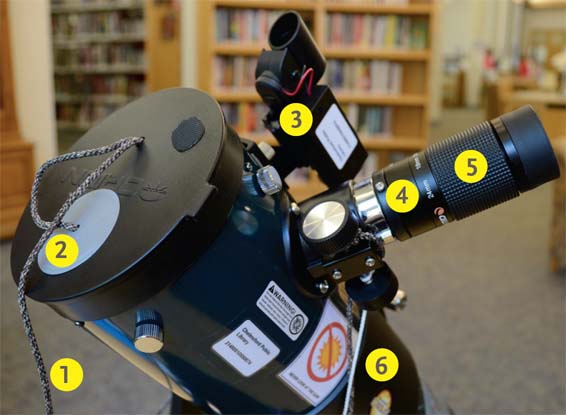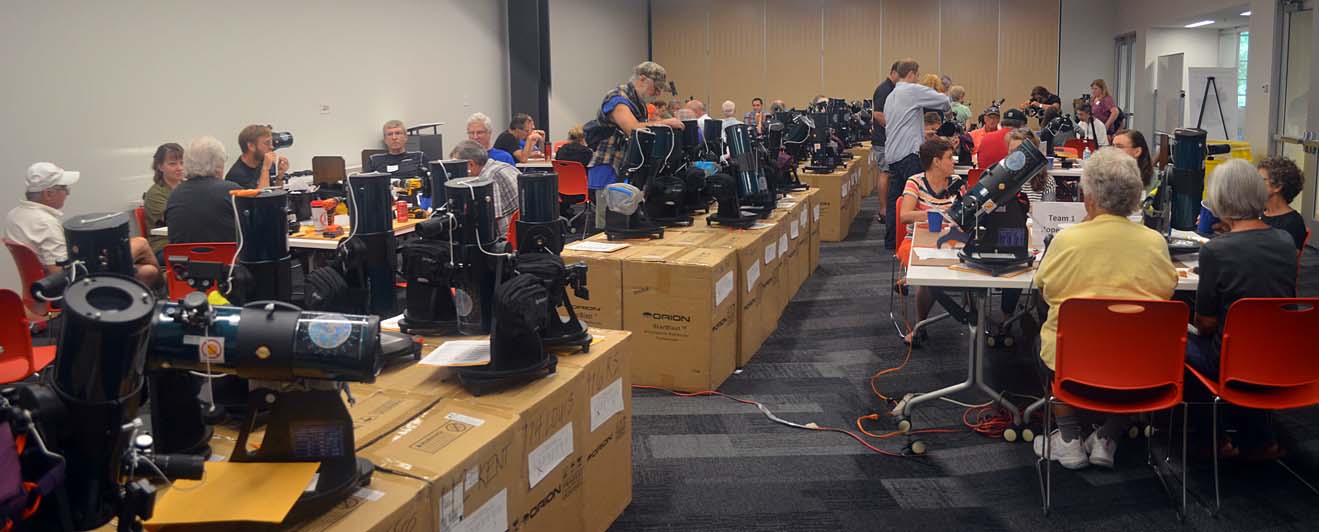Astronomy - “Library Telescope” Program Takes Off
From humble beginnings in 2008, a simple idea — equipping libraries with loaner telescopes — has caught on across the United States.
| game-changer (n): a person or event that alters the status quo in a significant and permanent way |

Thanks to an outreach program started in 2008, hundreds of specially modified Orion StarBlast 4.5 telescopes are now available to library patrons across the U.S.
Jennifer Stowbridge
Jennifer Stowbridge
The New Hampshire Astronomical Society is a typical local club, with a few score amateur skywatchers interested in telescopes and observing the night sky. And like pretty much every astronomy club, the NHAS has watched its membership gradually get older and grayer. Attracting a younger crowd has been a tough sell, despite an active outreach program with plenty of star parties and community involvement.
Then in late 2008, NHAS member Marc Stowbridge hit upon a novel idea. Why not take the concept of a "loaner telescope," which the NHAS already provided to its members, and extend it to his local library? That would allow its patrons — especially young ones — to check out a portable, user-friendly scope as if it were a book or DVD. So he took a small telescope, modified it a bit to perform well in unfamiliar hands, and donated it to his local library. It was an immediate hit.
So Stowbridge and other members of NHAS's Educational Outreach Committee found two libraries willing to lend telescopes in 2008 and donated another 10 the next year. Word soon spread (apparently librarians share good ideas a lot), and at last count more than 100 had been distributed statewide. Some participating libraries have months-long waiting lists of eager patrons; several have more than one on hand to meet the demand.
Orion's StarBlast 4.5: An Ideal Loaner Scope
Most people imagine a backyard telescope to be a long, skinny refractor sitting atop a spindly tripod. Of course, first-time buyers scoop up millions of these annually. However, Stowbridge and the NHAS team quickly settled on Orion's StarBlast 4.5 as their starting point. (Here's the S&T review of it from 2003.) It's economical, robust, and well built. It boasts quality optics that provide satisfying wide-field views. And it's very newbie-friendly.

Modifications to the beginner-friendly Orion StarBlast 4.5 tabletop reflector include: (1) adding “Can’t Lose Strings” to loose parts; (2) cutting a 2-inch hole in the end cap to reduce the Moon’s brightness; (3) installing an AA-battery pack for the red-dot finder; (4) adding setscrews in the focusing tube; (5) providing an 8-to-24-mm zoom eyepiece; and (6) adding a Sun warning and other stickers to the main tube.
S&T / J. Kelly Beatty
S&T / J. Kelly Beatty
But a just-out-of-the-box StarBlast still needed critical tweaks to endure the bumps and bruises that a loaner scope would likely endure. So the NHAS assembled a "build team" of volunteers to make some modifications. First, they replaced Orion's two standard-issue eyepieces with Celestron's 8-to-24-mm zoom eyepiece, which provides magnifications of 19× to 56×, and they used small, recessed set screws to anchor it firmly into the focusing tube.
Then they replaced the primary mirror's collimation screws — shiny temptations for inexperienced hands — with hard-to-turn locknuts (some clubs cover simply enclose the tube's back end with a plastic cover). And the endurance of the scope's red-dot finder is greatly extended by replacing its button battery with an external battery pack. Attaching "can't lose strings" prevent dust caps from being lost, and cutting a small hole in the main dust cap allows an overly bright Moon to be viewed comfortably.
To enhance each borrower's observing experience, club members affix a Moon map and solar-viewing warning to the tube and include a small pack containing a laminated 4-by-6-inch instruction manual, National Audubon’s pocket guide to the constellations, and a strap-on headlamp equipped with red LEDs.
Click here for details of how to make the suggested modifications.
I attended one of the NHAS "construction parties" last year to see these transformations firsthand. With practice, and with enough volunteers to create optical, mechanical, and electrical "tiger teams," each scope takes less than 2 hours of effort to be ready for placement. An important side benefit is the camaraderie among club members that I witnessed.
An Explosion of Telescopes
The NHAS program might have remained just a quirky success story had it not come to the attention of the Astronomical League. Thanks in part to the League's promotion of the idea among its affiliated societies, and in part to an October 2014 S&T article by League president John Jardine Goss, scores of clubs across the U.S. have started library-telescope programs of their own. Some are modest, with just a few StarBlasts making their debut, while other efforts have proven wildly popular.
One group that's really embraced the library-telescope program is the St. Louis Astronomical Society. SLAS members kicked off their effort in October 2014 (here's the press release), and the requests just kept pouring in. At last count, this club had placed 131 modified StarBasts in libraries in east-central Missouri and west-central Illinois.

In August 2016, members of the St. Louis Astronomical Society and 11 neighboring clubs spent all day modifying 48 StarBlast telescopes for placement in the region's libraries.
Donald Ficken
Donald Ficken
Even more impressive is the planning and execution that goes into making the modifications. The club's last work session, back in August, involved 60 volunteers from 12 different organizations. They took over a branch of the St. Louis County library to upgrade 48 StarBlasts during a 7½-hour frenzy of drilling, wiring, adjusting, and packaging. To get a sense of this mass-production telescope modification, check out the club's photo gallery from last August and two sets of photos (here and here) from the previous "build" in March 2016.
Even with discounts from Orion and Celestron, the cost per telescope package totals about $325. Some clubs (or individual members) choose to donate some telescopes outright, especially when introducing the program, but in most cases the libraries themselves pay — often in concert with contributions from "Friends of the Library" groups or local businesses.
The League is also active in spreading the program into new cities and towns. For the past two years, it has given away 10 telescope-eyepiece "startup kits" at its annual meeting. "This program is due to the vision and generosity of the Horkheimer Charitable Fund, Orion Telescopes, and Celestron," notes League president John Goss. "Without their support, we couldn't offer this program."
Making a Difference

This user-friendly tabletop telescope might be ready and waiting at a library near you.
S&T / J. Kelly Beatty
S&T / J. Kelly Beatty
Library telescopes are certainly increasing interest in amateur astronomy. According to Stowbridge, a typical borrower is an adult 30 to 40 years old with school-age children. He estimates that, on average six people use a telescope each time it's checked out.
But is the effort starting to draw more young people into astronomy? Solid stats are hard to come by, and in many regions the lending program is just getting started. Some librarians are intimidated or fear the scope will get damaged. Others worry about people looking at the Sun (no solar filter is provided). And some clubs have been reluctant to take on the commitment of time and resources.
However, the usual response ranges from positive to wildly enthusiastic. "What I've seen is that when one library has success with the scope, other branches soon want one too," Goss notes. So, for now, perhaps just getting more people to enjoy views of the Moon and planets through a decent telescope is reward enough.
Is your club participating in a library-telescope program, or have you used one of these specially-modified scopes? If so, add a comment below to let me know about your experiences.

No comments:
Post a Comment